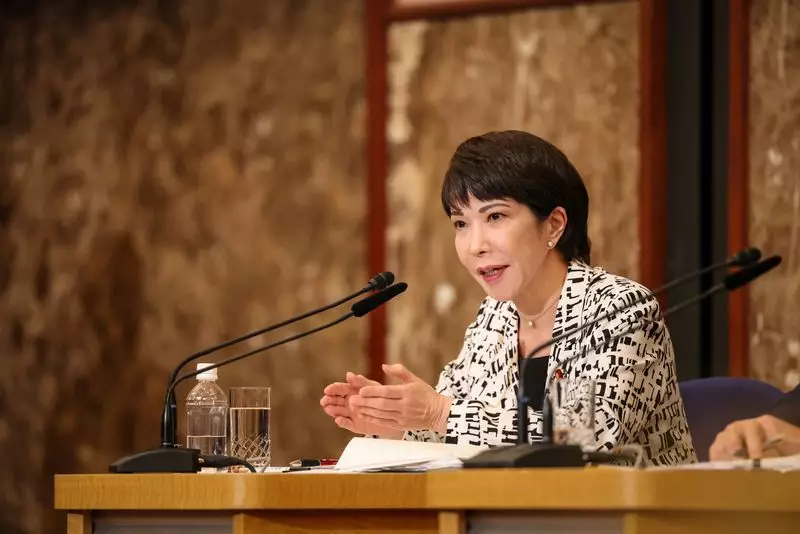Japan finds itself at a crucial crossroads in its economic trajectory, where leadership choices within the ruling Liberal Democratic Party (LDP) may significantly shape the nation’s policy in the months to come. Central to this debate is the stance on monetary policy, particularly the Bank of Japan’s (BOJ) interest rate strategies, which reflect broader concerns about economic recovery, inflation, and fiscal health.
Sanae Takaichi, the minister responsible for economic security, has recently emerged as a vocal advocate for maintaining ultra-low interest rates as a means to bolster an economic recovery that remains in a fragile state. Takaichi’s position comes in light of the BOJ’s recent decisions to adjust rates, including the abandonment of negative interest rates earlier this year and a modest hike in July that brought short-term rates to 0.25%. These moves were predicated on the notion that the economy was progressing towards a durable achievement of the elusive 2% inflation target.
In expressing her views, Takaichi asserted that it might have been premature for the BOJ to initiate any interest rate hikes this year. Her statements resonate with the predominant concern among economists and policymakers alike: the delicate balance of fostering growth while simultaneously managing inflationary pressures. As she positions herself as a strong contender in the upcoming political race, Takaichi’s economic philosophy underscores the critical importance of continued fiscal and monetary support.
The BOJ’s recent adjustments come against a backdrop of mixed economic signals. While certain indicators suggest a return to stability, the overall economic environment remains characterized by uncertainty, largely induced by global economic tensions and rising living costs. Furthermore, with BOJ Governor Kazuo Ueda hinting at the possibility of further rate increases once inflation stabilizes around the 2% mark, the balancing act becomes even more complex.
Ueda’s cautious optimism is contingent on sustaining wage growth alongside inflation; however, a significant fraction of economists surveyed by Reuters predicts additional rate increases before the end of the year. This backdrop raises pertinent questions about the intersection of monetary policy and the broader economic landscape, particularly in a context where rising interest rates could exacerbate the burden of Japan’s considerable public debt.
With incumbent Prime Minister Fumio Kishida signaling his departure from the LDP leadership post, the party must soon select a successor, a decision likely to have far-reaching implications for Japan’s economic policy. The leadership race features diverse perspectives, with candidates divided on how best to tackle the challenge of rising costs for consumers and businesses.
While a consensus emerges on the necessity for a spending package to alleviate these pressures, clarity on the funding mechanisms remains scarce. Candidates such as Taro Kono bring a nuanced viewpoint to the discussion, emphasizing the importance of fiscal health over mere short-term stimulative measures. Kono’s advocacy for a balanced approach reflects a sophisticated understanding of the potential long-term ramifications of excessive spending in the face of rising interest rates.
As Japan grapples with the implications of its public debt, discussion surrounding innovative financing options surfaces among LDP candidates. Toshimitsu Motegi’s suggestion to leverage the country’s substantial reserves for currency intervention presents a potential avenue for reimagining how Japan invests its assets. By considering the diversification of investments beyond U.S. government bonds, Motegi implies a shift toward a more proactive stance on generating higher returns while managing national financial resources judiciously.
This moment of transition introduces an opportunity for a more comprehensive dialogue about Japan’s economic future, prompting a reevaluation of both fiscal policy and underlying investment strategies. The upcoming leadership election could serve as a pivotal moment for the LDP, not merely in terms of leadership transition but in setting a new course for Japan’s economic policy moving forward.
As Japan prepares for a change in leadership amidst ongoing economic challenges, the perspectives championed by figures like Sanae Takaichi and Taro Kono will be integral to shaping policy directions. Balancing economic recovery with inflationary management requires not only visionary policies but also a robust dialogue within the ruling party. The decisions made in the coming weeks will undoubtedly leave a lasting imprint on Japan’s economic landscape, necessitating a strategic and thoughtful approach amidst a complex global economic milieu.


Leave a Reply